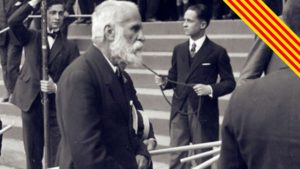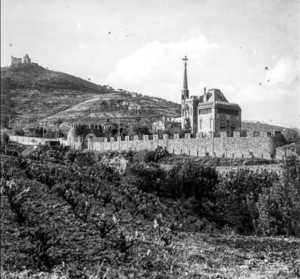January 13, 2023
The figure of Pepeta Moreu, and with it her influence on Antoni Gaudí, has remained in the shadows for most of the time, like so many other women in history who have been forgotten. It has recently been rediscovered, providing a new historical view not only of the life of the famous architect but also of the women of the time.
Pepeta Moreu, a woman ahead of her time
Considered today as a woman ahead of her time and qualified by some as Gaudi’s muse, Pepeta Moreu was born on June 16, 1857 in Mataró, into a wealthy family and liberal
Pepeta had two sisters (Magdalena and Agustina) and one brother (Josep Maria), being the oldest of them all. His mother was called Antònia Fornells de Moreu and his father Antonio Moreu.
The family lived in a spacious house in Mataró that had been built in 1864. It was a privileged home that had a well-equipped bathroom, which was very uncommon in the municipality during the 19th century. A luxury that only the lucky few could afford. In the center of the house they had a large hall where on holidays they invited numerous guests. The house also had a well-decorated chapel with the capacity to hold different ceremonies, from masses to communions.
Pepeta’s father was the owner of a sailboat called “Antonio” with which he traveled and did business in Cuba and Africa. This lifestyle led him to get involved in businesses of dubious reputation and to commit numerous infidelities, even fathering children with other women.
Pepeta was a red-haired woman, intelligent and of great beauty, so she never lacked suitors. In 1875, having just turned 18, the young Pepeta married Joan Palau, a Carlist captain who decided to use the dowry money to buy a steamer with which to carry out cabotage around North Africa, a merchant with goods such as wine and esparto.
The marriage with Joan Palau turned out to be hell for Pepeta, who had to endure the constant drunkenness and beatings of her husband, who also incessantly accumulated gambling debts. In 1878, in Orà, a city in the north-west of Algeria, Pepeta informed her that she was pregnant and asked her to nod her head, a change of life.
Joan Palau’s response was to reveal to the pregnant young woman that he was already married to another woman in Buenos Aires. He mis-sold the ship and abandoned her to her fate without leaving her a penny.
Alone in Orà and without money, Pepeta was able to get ahead by playing the piano in a bar. During this period she learned to speak French, which language she would later teach at the Cooperativa Mataronense. Finally, Pepeta was able to return to Mataró thanks to sailors who took pity on her situation and took her home.
His son was born healthy, but died of diphtheria on January 3, 1883, at the age of three. The Moreu family started the procedures to declare the marriage nullity between Pepeta and Joan Palau, finally achieving that the marriage was annulled for bigamy and that Pepeta could regain her legal status as a bachelor.
Gaudi’s impossible love
Described by her brother in his memoirs with the following words: “Blonde, with hair the color of old gold, almost mahogany, with a strange attractiveness that made one look at it”, it must have been a day around 1885 when the eyes of Antoni Gaudí saw Pepeta Moreu for the first time.
It was Salvador Pagès who introduced Gaudí to the Moreu family, precisely with the intention that he would meet the daughters.
Salvador Pagès, Gaudí’s friend and partner, was a textile industrialist who had founded the Cooperativa Obrera Mataronense. Given the ideology, very close to utopian socialism, he commissioned Gaudí to design an industrial complex following the structure of the workers’ colonies, incorporating innovative social benefits.
Pagès was also a friend of the Moreu family and in order to help them he had hired Pepeta and Agustina as teachers in the Cooperative of which he was the founder.
In those days, when Gaudí met the Moreu family, Pepeta was 27, Magdalena 23, Agustina 21 and the youngest son, Josep Maria, 12. Gaudí was 33 years old when he was introduced to Pepeta, who would be his great love.
Gaudí had been in love before. In 1871, aged 19, he fell in love with a young French woman who was visiting a friendly family.
Gaudí himself remembered this episode of his life: “I fell in love very much in those days, and I went to see her as much as I could; and she seemed to realize it and spoke to me very kindly, very, very…; so much so that I was drunk; but she was engaged, in her country, and the day of her return came and I didn’t have the courage to go and see her off, at the time she was leaving I was at home as if dead. After I didn’t know anything else about it, only that he had been married in his little town.’
Pepeta was a woman of liberal customs who had traveled a lot and who broke with the basic patterns of women of her time. Not only was she an exceptional pianist and spoke different languages, she was also very interested in politics, which was very unusual for women of that time as it was generally considered a subject reserved for men. Pepeta read anticlerical press and maintained a relationship with republican, socialist and anticlerical figures in Mataró.
Gaudí was captivated by Pepeta, even though they were completely opposite in character and thought.
Every Sunday he went to the Moreu home, where he enjoyed Pepeta’s musical performances and the murals that decorated the house, which represented different places visited by the father of the family during his business trips such as: the bay of Rio de Janeiro, a sailboat in the storm and various scenes of the Caribbean. In fact, Gaudí would be inspired by these decorative murals of the Moreu house for the decoration of the dining room of the Vicens house.
Gaudí always took his niece Rosita on Sunday visits. For four years, his attraction to Pepeta grew, and with the time he spent with the Moreu family, Gaudí became familiar with all the members of the family. In fact, the youngest of the family, Josep Maria Moreu, would end up starting a career in architecture as a result of the inspiration that Gaudí’s presence gave him.
This is how Antoni Gaudí fell in love with Pepeta and finally decided to declare his love for her. The answer he received was not what he expected. Pepeta was already engaged to another man and rejected him by showing him her fiance’s engagement ring.
Much has been speculated about how this rejection marked the rest of the brilliant architect’s life. It seems certain that this disappointment in love drove him to introspection and there are testimonies that state that he never returned to the Moreu house.
Unlike the words he left us about the French girl, about his love for Pepeta there is no evidence that Gaudí managed to record it, beyond some confessions to his close friend, the poet Joan Maragall, who it would refer to Gaudí’s unrequited love with the nickname “the German”.
Gaudí never fell in love again. As for Pepeta, the great platonic love of the architect, she married Josep Caballol (her fiance when Gaudí was declared to her) with whom she had four children. Years later, when she became a widow, she remarried her third husband, Josep Vidal.
On December 9, 1938, Pepeta Moreu died at the age of 81, the intelligent woman ahead of her time who captivated Antoni Gaudí, leaving an indelible mark on him.




